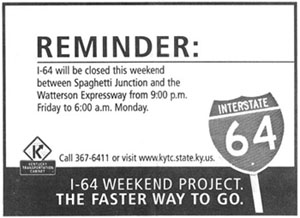4.0 Communication Strategies
This section describes a number of commonly used communication strategies and includes examples of how agencies have used these strategies. The section ends with a table that lists all of the strategies described and provides some characteristics that can help an agency determine which strategies to use.
4.1 Branding
Branding, such as distinctive project names and "trademark" graphics, logos, and catchphrases, is often an effective method to enable the target audience(s) to easily recognize any information related or pertaining to the work zone. The use of a brand assists the public with validating the accuracy of the information being issued. Delaware Department of Transportation (DOT), for example, created the "Traffic Creep" character, shown in Figure 4.1, for its public information and outreach campaign on the I-95 Reconstruction Project in 2000 [1]. Travelers were invited to "Beat the Creep" through actions such as carpooling or using transit. The Creep was brought out of retirement for use on outreach materials during major bridge repair work on I-95 in 2005.
Similarly, Illinois DOT developed "Jack Hammer", shown in Section 2.4, for its Upgrade I-74 Project in Peoria. This character was used on a variety of materials including the web site, on radio spots, and as a costumed character at schools and community events. Another way to use branding is demonstrated by the public information and outreach manager for the Springfield Interchange construction project in Virginia. When out in public he wears a polo shirt bearing the project logo to generate questions from the people he meets.
TIP: Provide downloadable logos that others can incorporate into presentations and materials, such as employee newsletters and newspaper articles.
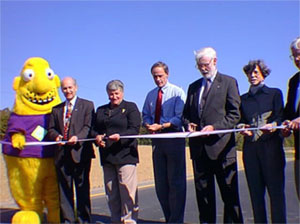
Figure 4.1 The "Traffic Creep" character used during major construction projects in Delaware. (Source: Delaware DOT)
4.2 Using the Mass Media
Radio, television, and newspapers are still some of the main ways people receive traveler information [2]. Hence, using these methods to share information should be a cornerstone of any public information and outreach campaign. Paid advertising is relatively expensive, but can be a cost-effective way to reach a wide audience. Paid advertising may be necessary in the case of dramatic changes to the road network such as full closure of an Interstate (see box). Regularly purchasing advertising space and on-air time may allow agencies to negotiate cheaper rates.
For its I-29 project in Fargo, the North Dakota DOT (NDDOT) was able to get one free newspaper advertisement for every two it bought.
Source: Presentation given by Kevin Gorder, Project Manager for I-29 Project, North Dakota DOT, at the FHWA Work Zone Focus State Workshop, April 19, 2005, URL: http://www.ops.fhwa.dot.gov/wz/publicinfostrategies.htm (Accessed 10/19/05).
For eight weekends in the summer of 2001, I-64 in Louisville, Kentucky was fully closed for rehabilitation. Prior to starting, the Kentucky Transportation Cabinet (KTC) engaged in an extensive media campaign. Advertisements were placed in major newspapers (see below). KTC also used creative radio commercials describing the possible outcome of being stuck on the Interstate if weekday construction was done instead of the weekend closures. These commercials put a positive spin on the decision to avoid the heaviest traffic by performing the construction during the weekend. In addition, the KTC sponsored traffic reports developed for the top AM radio stations. Major positive outcomes included only one work zone crash, no detour crashes, no traffic congestion, and the project was completed seven weeks early.
Source: Kentucky Transportation Cabinet
Free media (also known as "earned media"), such as new stories and traffic information, should also be used to the maximum extent. Large projects are typically considered newsworthy by local media outlets so it is relatively easy to get news coverage. For example, Figure 4.2 illustrates a newspaper article providing information on a weekend closure during the I-64 project in Kentucky.
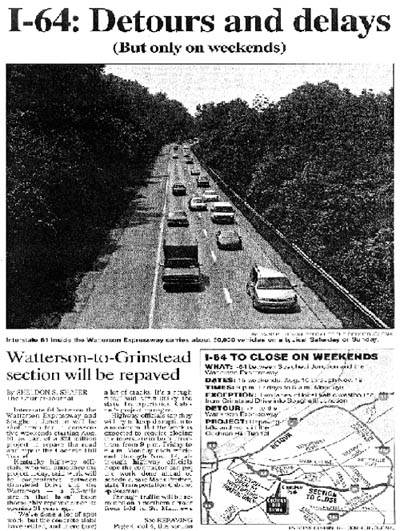
Figure 4.2 "Free Media": A newspaper article on weekend closure of I-64 in Kentucky published in the Louisville Courier–Journal. (Source: Kentucky Transportation Cabinet)
Nevertheless, it is important to establish a working relationship with reporters to encourage publicity that is positive, and information that is accurate. In addition, be sure to treat all media outlets, big or small, with the same level of care and attention.
Guides to working with the media are widely available and tend to make the same points:
- A successful media program requires more than just sending out a news release.
- Garnering favorable media attention often demands planning and creativity.
- Getting to know reporters who cover transportation and traffic can help ensure information about the project is included in traffic reports.
- Making information easily available with plenty of personal follow-up is necessary to developing an effective relationship with the media.
- Providing the media with accurate, up-to-date, and consistent information is important [3].
Before major work began on I-29, North Dakota DOT representatives visited all the local media outlets to inform them about the project and to answer their questions.
Source: Presentation given by Kevin Gorder, Project Manager for I-29 Project, North Dakota DOT, at the FHWA Work Zone Focus State Workshop, April 19, 2005, URL: http://www.ops.fhwa.dot.gov/wz/publicinfostrategies.htm (Accessed 10/19/05).
TIP: Develop a press kit with all the information needed to write stories about the project. This should include project information, frequently asked questions (FAQs), fun facts, and contact information.
Prior to and during the Upgrade I-74 project in Peoria, Illinois, the Illinois Department of Transportation developed and ran radio advertisements incorporating their fictional character Jack Hammer, including this one:
Jack: "Hey! This is Upgrade 74's mascot, Jack Hammer, with my pilot, Kenny." (Helicopter sound in background).
Kenny: "Yo!"
Jack: "We are in the I-74 traffic chopper checking out Peoria's rush hour."
Kenny: "You mean rush minute."
Jack: "Okay, we're over I-74 and uh…"
Kenny: "Here it comes…"
Jack: "And traffic's…smooth."
Kenny: "Exactly."
Jack: "Well, I mean I expected…"
Jack: "Wait a minute!! Adams and 74, two cars are merging!! The Horror!!"
Kenny: "Easy, Brando!!"
Jack: "Well, traffic's smooth now but construction's starting to heat up. So listen for "Keep-Your-Cool" promotions all week or visit upgrade74.com for more info."
Kenny: "Let's buzz Caterpillar."
Jack: "Yeah, let's go!!"
Source: Illinois Department of Transportation, audio file available on http://www.upgrade74.com/index.php/news/downloads.html (Accessed 11/22/05).
4.3 Web Sites
Web sites are one of the primary tools for disseminating (pre-trip) traveler information. Internet usage has skyrocketed over the past few years. In 2003, 162 million adults (about 75 percent of the 218 million resident population 18 or older) had Internet access [4]. Web sites have many advantages over other types of communication methods, with the primary advantage being that they can provide up to the minute information on a 24-hour basis.
There are usually two options for the use of a web site to provide information about a work zone project. Projects may be part of a larger-scale traveler information or planned lane closure web site. These types of web sites are usually implemented for an entire state, district, or geographic region and list information about many different projects. These types of sites may be useful for smaller projects in which information does not change frequently or in which there is not a lot of public information to post about the project.
The other option is to create a web site dedicated solely to the work zone project. This type of web site can provide both static and real-time information, including many of the other forms of project information such as all types of written material, traffic camera images, travel times, photographs, maps, and links to other sources of information. Moreover, many of these features can be made interactive with links to map icons and pop-up textual information and camera views. Project web sites are often used for larger projects and often these web sites have a web address that incorporates the name of the project. A successful project web site can be designed in many different ways, but most importantly, a web site must provide accurate and up-to-date information, be easy to locate, and people need to know about it. Better still is up-to-the-minute traffic information provided by traffic sensors or cameras. How often a web site is updated will depend on the project, but most large project web sites will need to be updated at least weekly.
Examples of project web sites include*:
- LBJ/Central Expressway Five Level Interchange in Dallas, Texas (I-635 and U.S. 75) – www.dallashighfive.org
- Springfield Interchange project in Springfield, Virginia (I-95 and I-495) – www.springfieldinterchange.com
- Interstate 29 project in Fargo, North Dakota – www.i29fargo.com
- Kansas City Triangle Interchange in Kansas City, Missouri (Hwy 71, I-435 and I-470) – www.kctriangle.org
*These web sites were available online as of October 2005. Project web sites may be taken offline as projects are completed.
Regularly updating a project web site is just one aspect of providing useful and trustworthy information. A web site with out-of-date and/or misleading information will likely have limited success. Additionally, care must be taken with the links provided on a project web site. The links must be current and provide credible information.
TIP: Retain ownership of the project web site domain name for a period of time after the project is completed in order to prevent others from purchasing the domain name and using it for undesirable means.
The Texas Department of Transportation's Katy Freeway reconstruction web site (http://www.katyfreeway.org) is just one example of how to design an attractive, informative, and user-friendly site. Information is organized into sections that are easy to navigate. These include: "Program Overview," "Timeline," "Newsroom," "Lane Closures/Updates," "FAQs," "Feedback/Contact Us," and "Contractor Information." A "What's New" section is a way to provide quick information to regular users. The "Lane Closures/Updates" link allows the user to view all recent and long term lane closures and also gives access to an interactive map, real time traffic camera links, and alternatives for traveling in the area. The "Program Overview" and "Timeline" sections provide project information including schedule and costs, and the "Newsroom" provides newsletters and press releases for the user to view, download, and print.
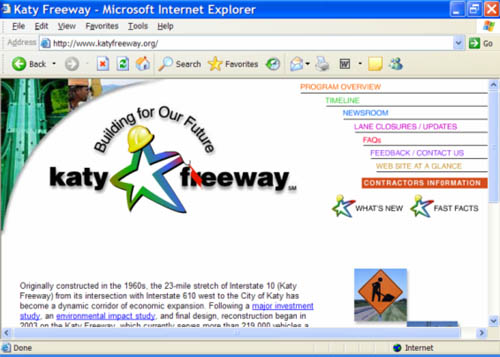
Source: Texas Department of Transportation, Katy Freeway Web Site, http://www.katyfreeway.org (Accessed 10/19/05).
4.4 Email Alerts
Email alerts provide another way for travelers to get timely information on work zone activity and traffic delays. Lane closures, delays, and incident/crash information can be distributed to travelers who have signed up to receive the information. Information can be sent to a computer, cell phone, or hand-held device. The sign up process is usually simple, requiring only that an email address be given via a form on an agency web site. Again, it is essential that the information provided be accurate and timely.
4.5 Printed Materials
There are many ways to employ printed materials to convey work zone information to the public, including brochures, newsletters, flyers, fact sheets, and maps. These materials can include upcoming project phases, events, and other important work zone details. Printed materials may be mailed, handed out, placed for pickup (in welcome centers, commuter stores, etc.), placed in newspapers, or distributed door to door. If the work zone is in a location frequented by truck traffic, the materials can also be handed out at truck stops and through local trucking associations. Printed materials may also be posted to project web sites for downloading and printing.
Innovative ideas for printed materials:
In Fargo, during a major reconstruction of I-29, North Dakota DOT produced what they call "leave behinds," flyers with project information and a map given to businesses and other organizations after a meeting. These proved so popular businesses began copying and distributing them at their own expense.
In Louisville, the Kentucky Transportation Cabinet distributed 50,000 door hangers alerting residents and businesses about the Interstate 64 project.
To publicize work zone information, North Carolina DOT distributed tray liners for use at rest-stop restaurants.
Sources: North Dakota and North Carolina: Presentations given by Kevin Gorder, Project Manager for I-29 Project, North Dakota DOT, and Jo Ann Oerter, State Technology Implementation and Maintenance Engineer, North Carolina DOT at the FHWA Work Zone Focus State Workshop, April 19, 2005, URL: http://www.ops.fhwa.dot.gov/wz/publicinfostrategies.htm (Accessed 10/19/05).
Kentucky: Interview with Kentucky Transportation Cabinet personnel, June 2005
4.5.1 Brochures/Flyers/Fact Sheets
Small fold-out brochures or one-page flyers and fact sheets are a great way to summarize a lot of general information about a project and are easy to mail, hand out at community meetings and events and other places, and make available for downloading from a web site. Eye-catching graphics, project logos, photographs, and maps can make these materials very effective for getting the message across and promoting project web sites, telephone hotlines, and other media.
The "Program Overview" fold-out brochure for the I-95 New Haven Corridor Improvement Program produced by the Connecticut DOT is shown in Figure 4.3 and contains the following sections:
- Project overview.
- Why are improvements needed?
- A description of project phases with color-coding related to a map.
- Impacts to traffic.
- Route and mode alternatives.
- Sources of up-to-date project information.
- A message from the Governor.
- A tear-off, postage-paid "keep me informed" page.
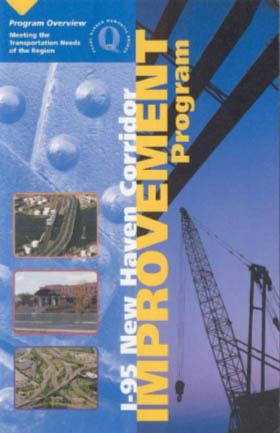
Figure 4.3 Connecticut DOT's fold-out brochure for the I-95 New Haven Corridor Improvement Program (Source: Connecticut DOT)
4.5.2 Newsletters
Periodic newsletters are another way to package various elements of a work zone project including project details, general traveler information, dates and times of community meetings, and contact information. When using a newsletter as a public information and outreach strategy, it is important to set a consistent timeframe for producing new editions of the newsletter. Establishing a consistent timeframe helps ensure that producing the newsletter does not "fall through the cracks" and lets readers know when to look for the next issue. If project details are constantly changing, then it may be useful to update the newsletter frequently, while a project that does not have a lot of new information may benefit from a less frequent distribution cycle.
The "HiLight Newsletter" published for the Katy Freeway reconstruction project is vibrant and easy to read. It recaps the work accomplished on the project each season. A "public corner section" is used to promote the Katy Public Information Office that was established to interact with the public, media, and other stakeholders. Facts are placed on a special section of each page in an effort to remind readers of the purpose and need for the project.
Source: Texas Department of Transportation, newsletters available on http://www.katyfreeway.org (Accessed 10/19/05).
4.6 Project Information Phone Line and 511
Travel information provided through a toll-free telephone "hotline" is accessible both pre-trip and en route. In addition, a project telephone line can be used to publicize public meetings, survey information, and for the public to leave comments and suggestions.
Travel information may also be made available through the 511 system, if 511 is available in the project region. Signs placed along the roadway using the logo shown in Figure 4.4 are used to alert drivers to the availability of 511 in a region. As of March 2005, there are twenty-six 511 systems operating in all or parts of 23 States, providing access to 511 services to almost 30 percent of the nation's population. One of the main advantages of a 511 system is accessibility. With the availability of cell phones today, a call can be made from almost anywhere at any time.
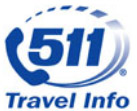
Figure 4.4 511 Logo (Source: http://ops.fhwa.dot.gov/511/index.htm)
In North Carolina, the 511 system is actively used to provide both real-time and static work zone information including the area of lane closures, start and end times, the expected severity of impacts, and, if available, detour information. Data for the system is collected from construction/maintenance personnel, transportation management center (TMC) personnel, and incident management assistance patrols. North Carolina DOT (NCDOT) is also working on integrating real-time information derived from several recently deployed smart work zone systems. To get the word out, NCDOT did significant marketing for the 511 system through the media, flyers, brochures, etc.
According to NCDOT, the biggest challenge of providing work zone information through its 511 system has been to provide accurate and timely information that does not conflict with its travel information web site, the Travel Information Management System (TIMS). Apart from instituting a strong quality control process, NCDOT found that identifying and working with stakeholders, such as construction contractors and emergency responders, from the very beginning is important. Relying on a large, diverse set of people for data also emphasized the need for training.
Source: Presentation Jo Ann Oerter, State Technology Implementation and Maintenance Engineer, North Carolina DOT at the FHWA Work Zone Focus State Workshop, April 19, 2005, URL: http://www.ops.fhwa.dot.gov/wz/publicinfostrategies.htm (Accessed 10/19/05).
TIP: To make it easy to remember, use a project related word as part of the telephone number. For example, Nebraska DOT's West Dodge Project used 592-ROAD (7623).
Source: Nebraska DOT
4.7 Dynamic Message Signs and Highway Advisory Radio
Other traveler information systems useful for informing travelers en route are dynamic message signs (DMS) and highway advisory radio (HAR). DMS can be used to publicize when a work zone will begin, other types of traveler information (for instance, "tune to 640 AM for traffic information"), as well as traffic delay and safety messages such as "Slow Traffic 5 Miles Ahead," and "Right Lane Closed 5 Miles Ahead." To be most useful, DMS should provide information at key junctions giving drivers plenty of time to make an informed decision about which route to take (see box).
HAR is helpful in that it can broadcast nonstop traffic information 24 hours a day. Due to Federal Communications Commission (FCC) regulations the broadcasts have a very restricted range, so the information aired needs to be tailored to travelers in a very small area.
Automated work zone information systems (AWIS) were deployed in central Arkansas by the Arkansas State Highway and Transportation Department (AHTD) in and around several major construction and rehabilitation projects on Interstates I-30 and I-40 near Little Rock. These projects were started in 2000 and completed in 2005. In mid-2004, three AWIS were operational on I-30 and I-40.
The AWIS installation and maintenance were contracted out to a private company that owns and operates the equipment. The AWIS equipment used included remote traffic microwave sensors, radio transmitters, DMS, and stationary video cameras mounted on trailers. The data collected by the sensors and cameras were processed automatically to determine traffic conditions, such as locations and severity of slowing or stopped vehicles. Information was then relayed back to motorists via DMS, highway advisory radio (HAR) stations, and the AHTD web site. The AWIS was set up to identify nine levels of severity that warranted communication with travelers. The nine alert levels were triggered on speed, volume, and occupancy levels detected by the sensors. During the most severe congestion, the DMS would display messages such as "Stopped Traffic Ahead At Mile Marker 123. Extended Delays Possible." When significant delays were detected, flashing beacons on HAR alert signs advised motorists entering the broadcast area to tune in with "urgent when flashing, tune to 1490 AM." If both lanes were closed, travelers were advised to use alternate routes.
While the roadside message boards and radios required a 5-minute relay time, sensor-recorded traffic speeds were transmitted instantaneously to the AHTD web site. Web site visitors saw a complete view of work zone traffic conditions with color-coded roadway segments indicating whether traffic was flowing, slowed, or stopped. Hovering the mouse over any of the equipment icons called up a live video image or displayed the text and audio messages motorists were receiving out on the road. An evaluation of a central Arkansas AWIS on I-40 determined that people were willing to change routes when warned of congestion caused by a work zone. Truckers were much more likely to take an alternate route than travelers as a whole.
Source: Managing Demand Through Travel Information Services, U.S. Department of Transportation, Federal Highway Administration, FHWA-HOP-05-005, 2005, URL: http://www.ops.fhwa.dot.gov/publications/manag_demand_tis/travelinfo.htm (Accessed 10/19/05).
4.8 Public Meetings, Workshops, and Community Events
As noted earlier, interaction with the public can be the determining factor in the success of a public information and outreach campaign. Hosting public meetings or developing a community task force gives the affected parties an opening to gain knowledge about the project but also to convey information and concerns to the project partners. Events such as ground-breaking ceremonies are great for grasping the attention of the public. Additional events that can be outlets for spreading information are fairs, school assemblies, tours, and informational workshops.
The New Mexico Department of Transportation (NMDOT) held nine special events with the public during the Big I reconstruction project. This included a groundbreaking, a halfway celebration, and a completion party, that involved more than 5,000 guests and partners. In addition to these events, NMDOT held a monthly Public Advisory Group meeting with effected neighborhoods and businesses during the Big I reconstruction project, gave presentations to civic and community groups, and offered tours of the construction site.
Source: Case Study: Big I Reconstruction Project: We're All In This Fix Together! http://www.cooneywatson.com/case_study_big_i.htm (Accessed 11/9/05).
4.9 Project Information Center
For large, long-term work zones, an information center can be a useful strategy to disseminate information and provide a key point of contact for the public. Like any store, an information center can be a destination for individuals or groups and also a place of interest for people just walking by. For the greatest benefit a center should be located in an area with high foot traffic in the general vicinity of the work zone location.
The Virginia DOT has a Springfield Interchange Information Office located in the Springfield Mall, within close distance to the project location. The Information Office has real-time construction camera monitors showing the actual construction site as well as a model of what the end result will look like. In addition, there are a wide range of materials aimed at travelers including brochures and maps and information about commuting alternatives. Information is also available on other projects in the area. To provide parents the opportunity to spend time learning about the project, the Information Office provides child-oriented educational materials and toys.
Source: Interview with Virginia DOT personnel, June 2005.
4.10 Videos
A powerful way to give the public a clearer view of the intended outcome of the work taking place is via video. Videos can be shown in an assortment of settings such as public meetings, fairs, school assemblies, and workshops. While videos can be expensive to produce, the advantage of a video is the projection of a consistent message.
For the reconstruction of I-235, Iowa DOT produced a video specifically aimed at helping businesses deal with the disruptions caused by the project.
Source: Iowa Department of Transportation, "I-235 Reconstruction Project, 2004 Communications Plan, Approved January 8, 2004."
4.11 Major Characteristics of Selected Communication Strategies
Table 4.1 lists the communication strategies discussed in this section and provides a summary of some of their major characteristics, including target audience type, applicability, timing, and general cost information.
| Strategy | Primary Target Audience |
Benefits | Issues | Timing | Relative Cost to Project [5] |
|---|---|---|---|---|---|
Web site |
|
|
|
|
Low/ |
Web-connected |
|
|
|
|
Medium |
Email alerts |
|
|
|
|
Low |
Brochures/ |
|
|
|
|
Low/ |
Public meetings/ |
|
|
|
|
Low |
Paid newspaper advertising |
|
|
|
|
Medium/ |
Newspaper articles |
|
|
|
|
Low |
Paid TV advertising |
|
|
|
|
Medium/ |
TV traffic news |
|
|
|
|
Low |
Paid radio advertising |
|
|
|
|
Medium/ |
Radio traffic news |
|
|
|
|
Low |
Maps |
|
|
|
|
Low/ |
Employee newsletters |
|
|
|
|
Low |
CB radio network |
|
|
|
|
Low |
Information center or kiosk |
|
|
|
|
Low/ |
Billboards |
|
|
|
|
Medium |
Project hotline/ |
|
|
|
|
Low/ |
Dynamic message signs (DMS) |
|
|
|
|
Low/ |
Highway advisory |
|
|
|
|
Low |
Press kit |
|
|
|
|
Low/ |
Business |
|
|
|
|
Low/ |
Branding |
|
|
|
|
Medium |
Videos |
|
|
|
|
Medium/ |
- Fact Sheet 4 – Delaware's Survival Plan for the I-95 Shutdown, FHWA-OP-00-025, July 2000, http://www.ops.fhwa.dot.gov/wz/practices/factsheets/factsheet4.htm (Accessed 10/19/05) and Full Road Closure for Work Zone Operations: A Case Study. Reducing the Impact of Construction During the Rehabilitation of a Major Interstate Highway. Interstate 95 in Wilmington, Delaware, FHWA-OP-05-012, December 2004, http://www.ops.fhwa.dot.gov/wz/docs/Delaware_v3/index.htm (Accessed 10/19/05).
- Managing Demand Through Travel Information Services, U.S. Department of Transportation, Federal Highway Administration, FHWA-HOP-05-005, 2005, http://ops.fhwa.dot.gov/publications/manag_demand_tis/travelinfo.htm (Accessed 10/19/05).
- Community How To Guides On Underage Drinking Prevention, Guide 7: Community Guide on Media Relations, U.S. Department of Transportation, National Highway Traffic Safety Administration, DOT HS 809 209, March 2001, http://www.nhtsa.dot.gov/people/injury/alcohol/Community%20Guides%20HTML/Guides_index.html (Accessed 01/26/05).
- U.S. Census Bureau, Statistical Abstract of the United States: 2003 (Washington, DC: 2004), p. 735.
- Costs are presented as low/medium/high because actual costs will depend on the scope of the strategy, and in some cases, location (e.g., newspaper advertising cost will vary greatly across different regions of the country).
